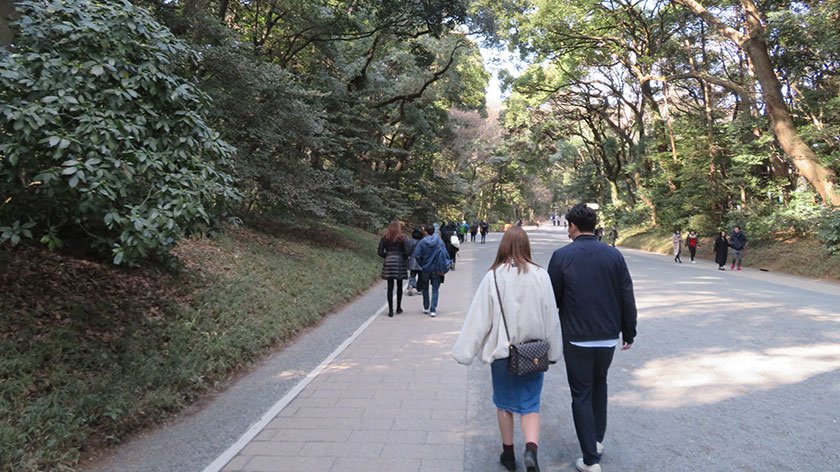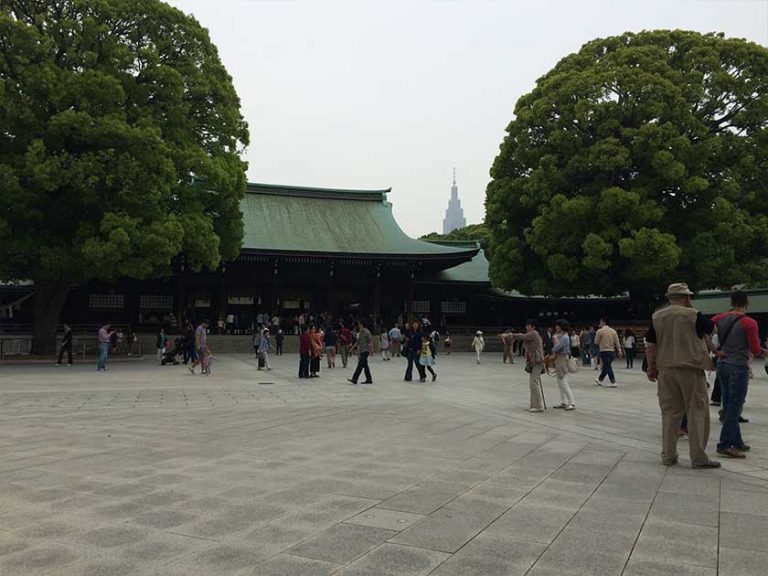
The Meiji Shrine, or Meiji Jingu, is an essential stop for anyone visiting Japan. It is a great way to see some Japanese culture, enjoy a walk through the woods, and – if lucky – see a traditional Japanese wedding. The accessibility is a bit of a mixed bag, though. While there is a nice wheelchair accessible toilet and great ramps right up to the main sanctuary, it is found at the end of a rather long walk down a gravel path which may be difficult for people who are slow walkers or use manual wheelchairs. Check out our review!
General Information
After the death of Emperor Meiji, the government built Meiji Shrine in recognition of his role in the Meiji Restoration and to house the deified spirits of the emperor and his wife, Empress Shoken. To honor the couple, an iris garden that was frequently visited by the couple was chosen. Though the original building was destroyed during World War II but was rebuilt after a public fundraising effort in 1958.
The Meiji Shrine is surrounded by a forested area that covers 70 hectares. The trees making up the forest were donated by people from all across Japan. The shrine complex is made up of two major areas: the Naien (housing the shrine complex) and the Gaien (including some sports complexes and facilities for weddings).
The shrine is open from sunrise to sunset every day of the year. While the garden can be entered for a fee, the main area is free of charge.
Getting There
There are two stations that serve the Meiji Shrine, so it will depend on where you are coming from. Here are the locations of wheelchair accessible exits:
- Meiji Jingu Mae Station (Tokyo Metro Chiyoda Line and Fukutoshin Line)
- Harajuku Station (JR Yamanote Line、Omotesando Entrance)
Clicking on the station name will show you a map of station layout, showing exits with elevators and the location of accessible toilets.
Wheelchair Accessibility
As mentioned above the accessibility of Meiji Shrine is a mixed bag. The best accessibility feature would definitely be the ramps in the shrine. Every effort has been made to provide smooth ramps that fit with the atmosphere. In most traditional shrines, the area where prayers are offered are at the top of a flight of steps. While this is the case at Meiji Shrine as well, there is a ramp that lets anyone get up front and see inside.
There is also a nice accessible toilet available. However, it should be noted that for an area this size, you would expect there to be more. It is located at the Bunkakan (Culture Center – next to the big barrels of Japanese sake). While the other toilets look like they are new and you would expect them to have an accessible toilet – they don’t!
The biggest challenge is the length of the main pathway. For an electric wheelchair, it poses no problems, but may be hard for slow walkers and those in manual wheelchairs. From the main entrance to the shrine itself, there is a 700m pathway made of thin gravel. Thankfully, the shrine recently added paved paths on either side of the gravel.

A small, but steep, bridge is located near the beginning of the path. It is not insurmountable, but does add unnecessary effort to reach the shrine.
The gardens are not accessible due to stairs nearly immediately after entering, however the garden is not the main feature and most visitors are not even aware it exists.
Conclusion
Visiting Meiji Shrine is a must if you are in Tokyo. The ramps in the shrine complex and the barrier free toilet mean that it is quite accessible to most people with a disability. However, there is only one for the entire site, which is unfortunate. The distance and the gravel path may add an extra challenge for those in manual wheelchairs or have difficulties with distances. If you have ever visited Meiji Shrine, please contact us or leave a comment below to let us know what you thought!


















